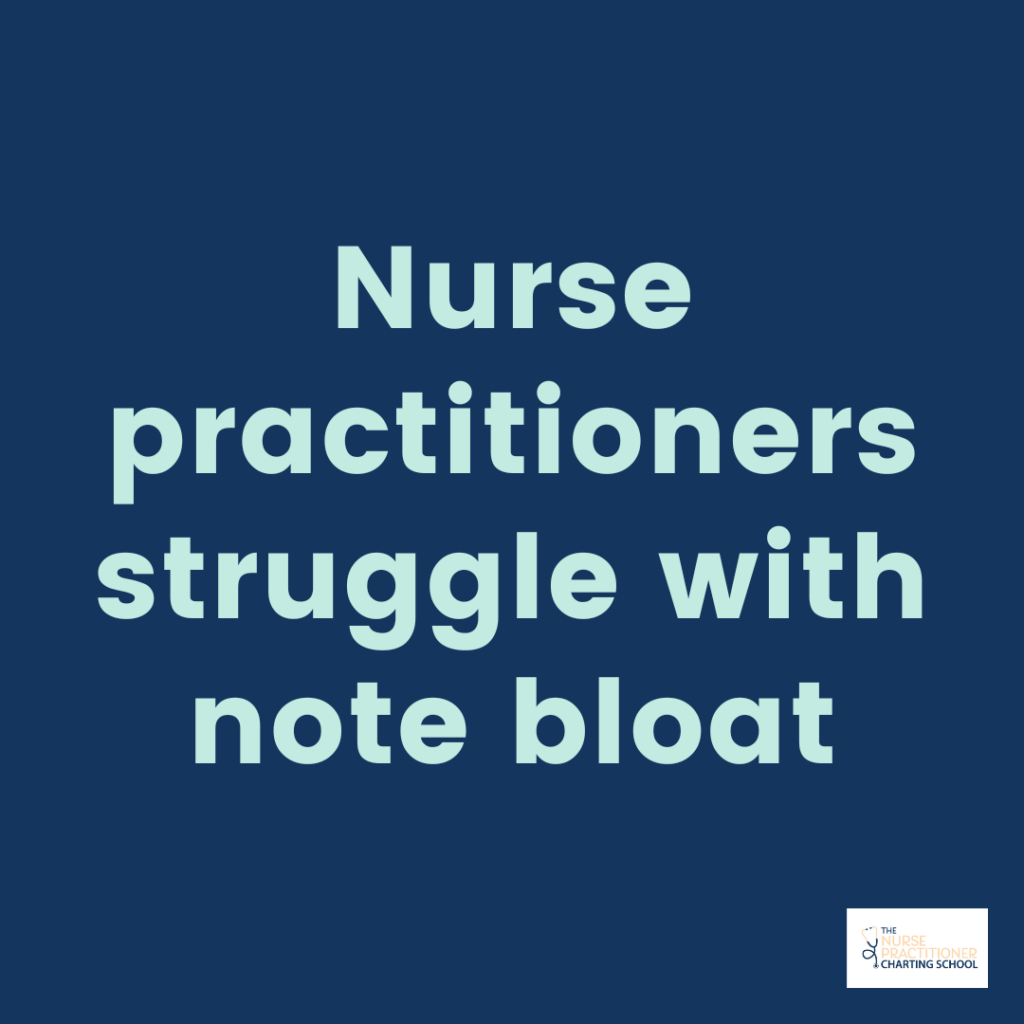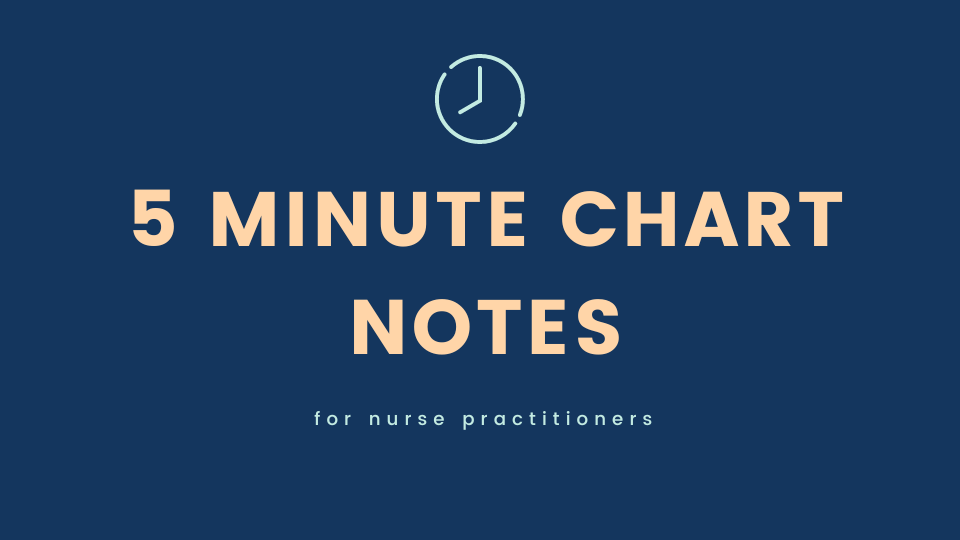In today’s healthcare landscape, documentation is an essential part of a nurse practitioner’s daily routine. But spending too much time writing a chart note can lead to staying late at the office, bringing charts home, disrupting work-life balance, and ultimately causing nurse practitioner burnout. The simple answer to this is avoid the “note bloat” and create problem-focused chart notes.
Unfortunately, this is challenging for nurse practitioners. There are several reasons why nurse practitioners struggle with note bloat. This article will take a look at some of the negative outcomes of over documentation and also why nurse practitioners struggle with note bloat.
But first, let’s define the phrase “note bloat.” Note bloat refers to the excessive and often redundant documentation that fills electronic health records (EHRs). Note bloat is caused by adding too much, unnecessary information which leads to over documentation.
As we will address in this article, nurse practitioners struggle with note bloat which can ultimately lead to nurse practitioner burnout. Understanding why nurse practitioners are particularly prone to note bloat is critical to addressing this issue and finding viable solutions.
Evolution of documentation in healthcare
Before delving into why nurse practitioners face this challenge, it’s important to understand the historical context of medical documentation. Traditionally, healthcare documentation was paper-based and relatively concise. Nurse practitioners would jot down essential notes during or after patient visits, capturing critical information while leaving out extraneous details.
The advent of electronic health records promised to streamline and improve the accuracy of medical documentation. EHRs were designed to enhance communication, reduce errors, and provide comprehensive patient histories accessible to all healthcare providers. However, the transition from paper to digital records brought its own set of challenges, particularly regarding the volume and complexity of documentation.
Reasons nurse practitioners struggle with note bloat
Here are some reasons why nurse practitioners struggle with note bloat.
Charting requirements as a RN
Many nurse practitioners previously worked as a registered nurse (RN), and a majority worked in a hospital setting. As a RN in a hospital setting, the expectation is to document everything that happened to that patient during the 12 hour shift. RNs document when the patient goes to the restroom, the characteristics of a bowel movement, other healthcare professionals that visit the patient, description of a wound and dressing change, etc. RNs are told, “If it’s not documented, it didn’t happen.” This mindset can carry on to the role as a nurse practitioner.
However, there is a significant difference in the charting as a RN vs. a NP. Nurse practitioners struggle with note bloat because they are focused on this mindset of charting EVERYTHING. But this is not possible when a nurse practitioner is seeing 4 patients in an hour vs. caring for 4 patients over a 12 hour shift as a RN. Nurse practitioners struggle with note bloat and need to overcome this mindset shift.
Training in nurse practitioner school
If you are like me, you did not learn how to properly chart in nurse practitioner school. When I started in primary care, I had to teach myself how to chart. And if you did learn in school, you were likely required to create very comprehensive and detailed chart notes. Unfortunately, this is not the same as charting in the real world. Nurse practitioners struggle with note bloat because that is what they learned in nurse practitioner school. They were not taught how to create short and sweet, problem-focused chart notes.
Once a nurse practitioner gets into a job, there is little training from employers. I know for my own practice, I wanted more feedback on my chart notes and choosing the correct Evaluation and Management Codes. Charting is such an important part of our work as nurse practitioners and it’s important for us to be educated on how and what to chart. So many nurse practitioners struggle with note bloat because we are never really taught how to chart as a provider.
Billing and coding requirements
Billing and coding systems also play a crucial role in the documentation burden faced by nurse practitioners. In the past, the amount and detail of documentation directly impacted the level of reimbursement from insurance companies. Higher levels of service, which corresponded to more detailed documentation, resulted in better compensation. Consequently, nurse practitioners often felt compelled to include more information than clinically necessary to ensure appropriate reimbursement for their services.
The coding process for outpatient visits changed in 2021. And the coding process for inpatient, ER, skilled nursing facilities was updated in 2023. The focus on the changes was the elimination of note bloat. Now nurse practitioners can choose the correct evaluation and management code based on time or medical decision making. They no longer need to add extra information just to get a higher level of care. These changes are meant to help nurse practitioners struggle with note bloat.
If you need more help with learning the billing and coding process, check out this course!
Fear of medical malpractice
Another reason why nurse practitioners struggle with note bloat in the fact that they feel like they need to cover their butts legally. Many nurse practitioners fear a medical malpractice suit and think if they add more and more information into the chart that they will be better off. APRNs create very comprehensive and detailed chart notes because they think this will protect them from a medical malpractice suit.
However, that is not the case. Sometimes nurse practitioners can actually add too much information into the chart note which can, “open a can of worms.” If a nurse practitioner mentions a patient’s question or concern within the history of present illness, they should be sure to address it throughout the rest of the chart note. The phrase “less is more” is vital (pun intended) for chart notes. Many nurse practitioners create note bloat because they fear implications from a medical malpractice case.
EHR design and usability issues
The design and usability of EHR systems themselves contribute to note bloat. Many EHR systems are not user-friendly and require significant time and effort to navigate. Poor interface design, cumbersome data entry processes, and a lack of intuitive features can make documentation a time-consuming task.
Many EHR systems are designed to capture a wide range of data points, leading to verbose and detailed notes. While some of this information is clinically relevant, much of it is superfluous and contributes to note bloat. The EHR causes nurse practitioners struggle with note bloat.
Charting resources for nurse practitioners
Nurse practitioners struggle with note bloat for multiple reasons. Our experience as RNs, billing requirements, and suboptimal EHR systems contribute to the excessive documentation burden faced by NPs. This not only impacts their job satisfaction and well-being but also the quality of patient care and the efficiency of the healthcare system.
As The Nurse Practitioner Charting Coach, I put together a training: 5 Minute Chart Notes!
This course teaches nurse practitioners how to avoid the note bloat and create problem-focused chart notes that takes less than 5 minutes to write!
This course will teach you what you didn’t learn in nurse practitioner school and help you save time charting!
Check out more information here!

Erica D the NP is a family nurse practitioner and The Nurse Practitioner Charting Coach. Erica helps nurse practitioners STOP charting at home! Erica created The Nurse Practitioner Charting School to be the one stop for all documentation resources created specifically for nurse practitioners. Learn more at www.npchartingschool.com
Follow on Facebook: The Nurse Practitioner Charting SchoolAnd on Instagram: @npchartingschool
Free training: 4 charting tips to help nurse practitioners get their time back! Sign up here!




